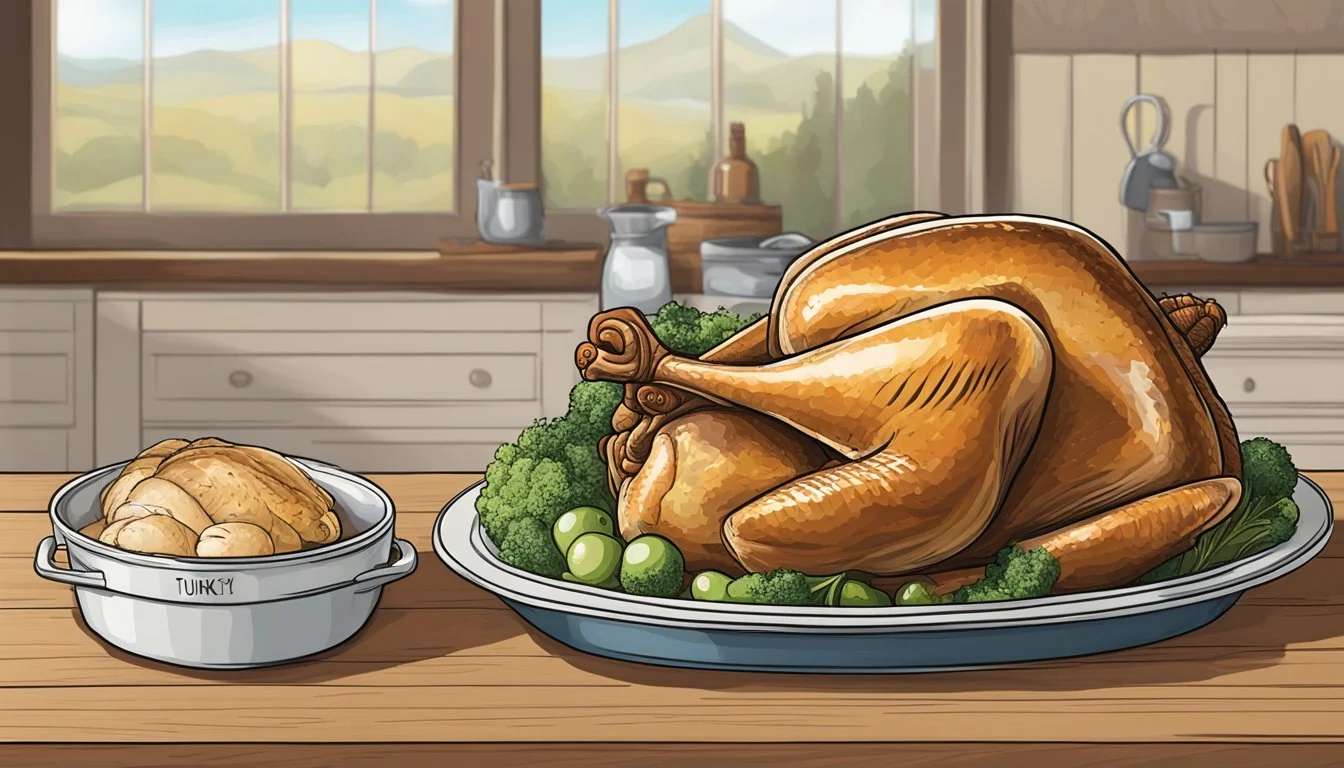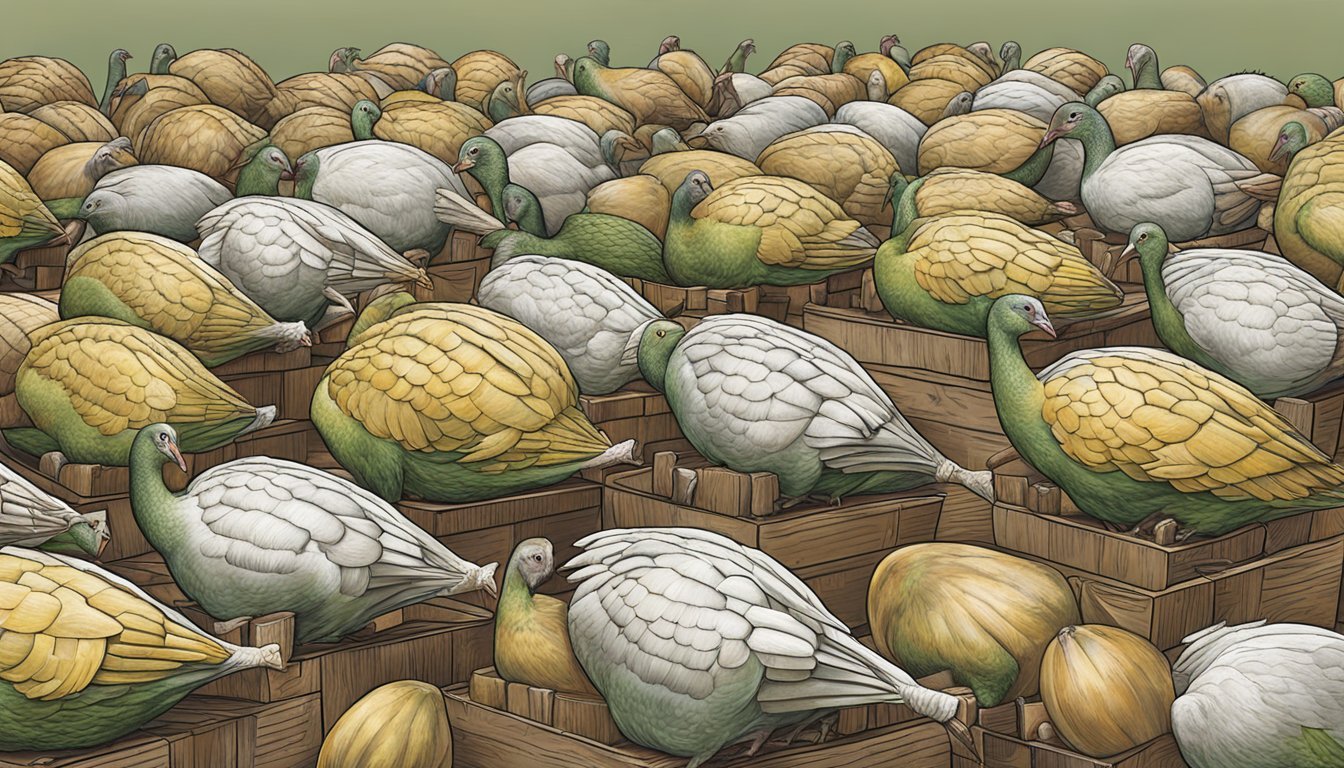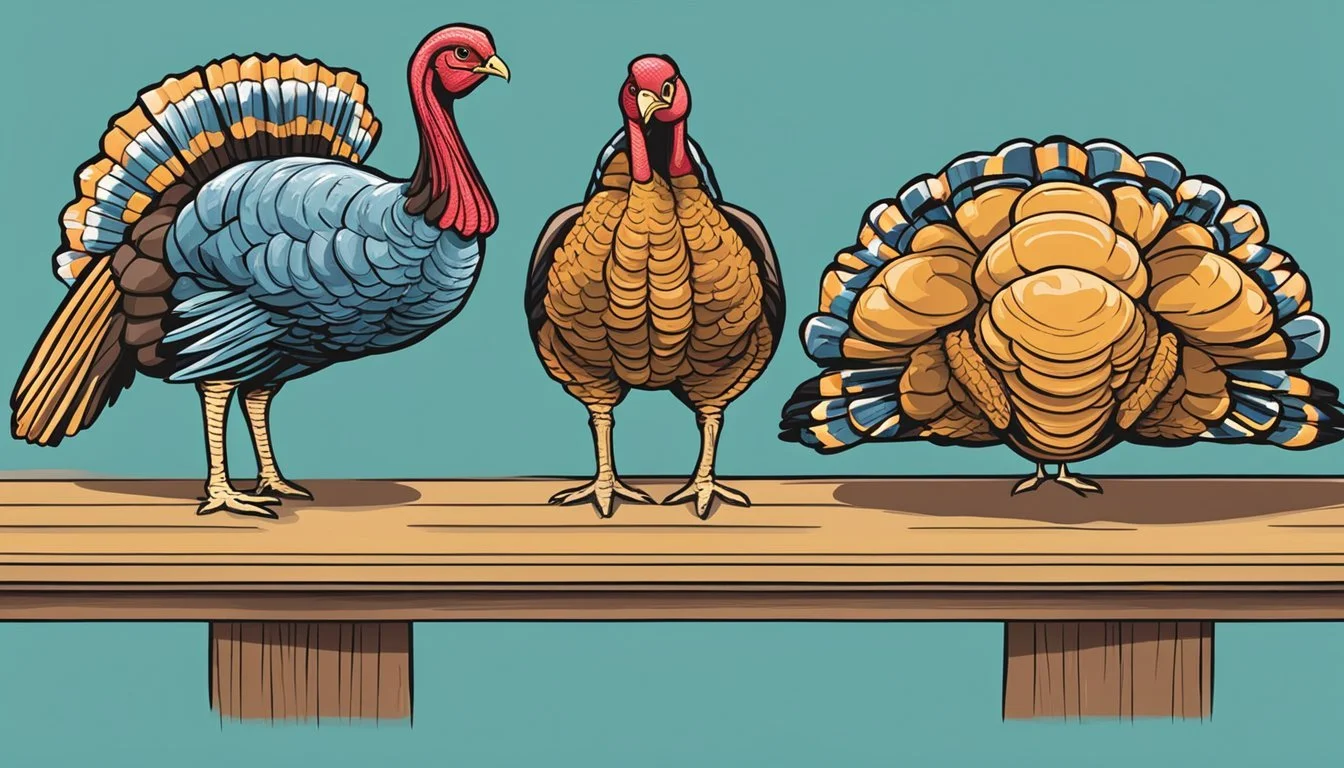Frozen vs Fresh Heritage Turkey: A Thanksgiving Taste Test
When it comes to choosing a turkey for your holiday feast, the decision between frozen and fresh heritage turkeys can significantly impact your dining experience. Heritage turkeys, known for their rich flavor and superior texture, offer a unique taste compared to conventional breeds. Fresh heritage turkeys typically provide a more pronounced, slightly gamey flavor and retain more moisture, resulting in a juicier bird when cooked properly.
Frozen heritage turkeys present a convenient option for those planning ahead. They can be purchased well in advance and stored until needed. While freezing may slightly affect the texture, many find the difference negligible when prepared with care. The freezing process can also help preserve the turkey's flavor and nutrients, ensuring a high-quality meal even months after purchase.
Ultimately, the choice between fresh and frozen heritage turkeys often comes down to personal preference, availability, and timing. Fresh turkeys require careful planning and prompt cooking, while frozen options offer flexibility and extended storage. Regardless of the choice, both can deliver an exceptional culinary experience when prepared with skill and attention to detail.
Understanding Heritage Turkeys
Heritage turkeys represent a return to traditional, sustainable turkey farming practices. These birds offer unique flavor profiles and genetic diversity compared to conventional broad-breasted turkeys found in most supermarkets.
Defining Heritage Turkey
Heritage turkeys are domesticated birds that maintain characteristics of their wild ancestors. They can mate naturally, have longer lifespans, and grow at a slower rate than commercial turkeys. Heritage breeds include Narragansett, Bourbon Red, Standard Bronze, and others recognized by the American Poultry Association before 1950.
These turkeys are typically raised free-range or pastured, allowing them to forage outdoors. Their diet consists mainly of grass, insects, and supplemental feed without added hormones or unnecessary antibiotics. This natural lifestyle contributes to their distinct flavor and texture.
Heritage turkeys have a more proportionate body shape, with longer legs and smaller breasts compared to industrial breeds. Their meat tends to be firmer and more flavorful, often described as richer or "gamier" than conventional turkey.
History and Significance
The domestication of wild turkeys began over 2,000 years ago by indigenous peoples in North and Central America. European colonists later brought these birds back to Europe, where new breeds were developed and then reintroduced to America.
In the mid-20th century, the turkey industry shifted towards faster-growing, broad-breasted varieties to meet increasing demand. This led to a decline in heritage breeds, with some nearing extinction. By 1997, fewer than 1,500 breeding heritage turkeys remained in the United States.
Conservation efforts by organizations like The Livestock Conservancy and small-scale farmers have since helped revive these breeds. Heritage turkeys now play a crucial role in maintaining genetic diversity and preserving traditional farming practices.
Breeding and Raising Practices
Heritage turkey breeding focuses on maintaining the birds' natural abilities and characteristics. Unlike commercial turkeys, which require artificial insemination, heritage breeds can reproduce naturally. This ensures genetic diversity and helps preserve traits that have evolved over centuries.
Farmers raising heritage turkeys typically employ sustainable practices. The birds are given ample outdoor space to roam, forage, and exhibit natural behaviors. This pastured approach allows them to consume a varied diet of grass, insects, and seeds, supplemented with organic feed when necessary.
Growth rates for heritage turkeys are slower than their commercial counterparts. While this extends the raising period, it results in a more developed flavor profile and healthier birds. Heritage turkeys generally reach market weight in 24-28 weeks, compared to 14-18 weeks for conventional turkeys.
Comparing Fresh and Frozen Turkeys
Fresh and frozen turkeys offer distinct qualities that impact taste, texture, and convenience. Each option presents unique characteristics in terms of flavor, moisture retention, and preparation requirements.
Quality and Texture Differences
Fresh turkeys typically have a firmer texture compared to their frozen counterparts. The natural moisture content in fresh birds contributes to a juicier end product when cooked properly. Frozen turkeys, on the other hand, may experience some cellular damage during the freezing process, potentially affecting texture.
Fresh turkeys require less preparation time, as they don't need thawing. This can be advantageous for last-minute meal planning. Frozen turkeys demand advance planning, with thawing times of approximately 24 hours for every 4 pounds.
Quality can vary between fresh and frozen options. Fresh turkeys are often perceived as higher quality due to their shorter storage time. However, modern freezing techniques have significantly improved the quality retention of frozen birds.
Flavor Profiles
Fresh turkeys are known for their robust, natural flavor. The lack of freezing helps preserve the bird's inherent taste. Some describe fresh turkeys as having a slightly "gamey" flavor, which appeals to those seeking a more traditional taste.
Frozen turkeys generally have a milder flavor profile. The freezing process can subtly alter taste, though many find the difference negligible. Both fresh and frozen turkeys benefit from proper seasoning and cooking techniques to enhance their flavors.
Brining can improve the taste of both fresh and frozen turkeys. This process helps retain moisture and infuse additional flavors, regardless of the turkey's initial state.
Nutritional Aspects
Nutritionally, fresh and frozen turkeys are quite similar. Both options provide excellent sources of protein, with minimal differences in overall nutrient content. The freezing process does not significantly impact the turkey's nutritional value.
Fresh turkeys may have a slight edge in vitamin retention, as some water-soluble vitamins can be lost during the thawing of frozen birds. However, this difference is generally minimal and doesn't substantially affect the turkey's overall nutritional profile.
Protein content remains consistent in both fresh and frozen turkeys. A 3-ounce serving typically provides about 26 grams of protein, making turkey a lean meat option for health-conscious consumers.
Moisture retention can affect the perceived juiciness of the cooked turkey. Fresh turkeys often retain moisture better, while proper thawing and cooking techniques are crucial for maintaining moisture in frozen birds.
Availability and Selection
Turkey availability and selection vary throughout the year. Grocery stores and butchers offer different options with distinct labels and certifications. Understanding these factors helps consumers make informed choices.
Seasonal Availability
Fresh heritage turkeys are most abundant in November and December. Many farms take pre-orders for Thanksgiving and Christmas. Frozen heritage turkeys may be available year-round at specialty stores or online retailers.
Grocery stores typically stock frozen turkeys all year. Fresh turkeys appear in coolers 1-2 weeks before major holidays.
Some butcher shops offer fresh heritage turkeys with advance notice, even outside peak seasons.
Choosing the Right Turkey at the Store
Look for turkeys with no signs of freezer burn or discoloration. Check the sell-by date on fresh turkeys.
Consider the size needed: allow 1-1.5 pounds per person for leftovers. Smaller turkeys (under 14 pounds) are often hens, while larger birds are typically toms.
Feel the breast area through the packaging. It should be firm, not soft or mushy.
Fresh turkeys may have a slightly higher price but offer convenience for last-minute purchases.
Understanding Labels and Certifications
USDA grades indicate quality: Grade A is the highest. "Fresh" means the turkey has never been below 26°F. "Frozen" indicates 0°F or lower.
Organic turkeys are certified by the USDA. They're raised without antibiotics and fed organic feed.
"Free-range" means turkeys have outdoor access. "Natural" indicates minimal processing without artificial ingredients.
Kosher turkeys are processed under rabbinical supervision. They're salted, which can affect flavor and texture.
Heritage turkeys may have breed-specific labels like Bourbon Red or Narragansett.
Preparation Techniques
Proper preparation is crucial for achieving a delicious heritage turkey, whether fresh or frozen. The key steps include thawing, brining, and roasting, each contributing to the bird's flavor and texture.
Thawing Frozen Turkey
Thawing a frozen heritage turkey requires patience and planning. Place the turkey in the refrigerator, allowing 24 hours of thawing time for every 4-5 pounds. A 15-pound turkey will need about 3-4 days to thaw completely.
For faster thawing, submerge the turkey in cold water. Change the water every 30 minutes to maintain food safety. This method takes about 30 minutes per pound.
Never thaw a turkey at room temperature, as this can promote bacterial growth.
Once thawed, remove the giblets and neck from the cavity. Rinse the turkey inside and out with cold water, then pat dry with paper towels.
Brining Tips for Improved Flavor
Brining enhances the turkey's moisture and flavor. Create a basic brine by dissolving 1 cup of salt and 1/2 cup of sugar in 1 gallon of water. Add herbs and spices like rosemary, thyme, and peppercorns for extra flavor.
Submerge the turkey in the brine, ensuring it's fully covered. Brine for 12-24 hours in the refrigerator.
For a dry brine, mix salt, sugar, and herbs. Rub this mixture under the skin and inside the cavity. Refrigerate for 24-48 hours.
After brining, rinse the turkey thoroughly and pat dry before roasting.
Roasting Guidelines for Optimal Taste
Preheat the oven to 425°F (218°C). Place the turkey breast-side up on a rack in a roasting pan.
Brush the skin with melted butter or oil. Season with salt, pepper, and herbs.
Roast for 30 minutes, then reduce the temperature to 350°F (175°C). Continue roasting, basting every 30 minutes.
Use a meat thermometer to check for doneness. The internal temperature should reach 165°F (74°C) in the thickest part of the thigh.
Cooking times vary based on weight:
8-12 lbs: 2.5-3 hours
12-16 lbs: 3-3.5 hours
16-20 lbs: 3.5-4 hours
Let the turkey rest for 20-30 minutes before carving to allow juices to redistribute.
Health and Food Safety Considerations
When dealing with heritage turkeys, whether fresh or frozen, proper handling is crucial to ensure food safety and protect health. Careful attention to storage, temperature control, and cooking practices helps minimize risks.
Understanding the Risk of Bacteria
Raw poultry can harbor harmful bacteria like Salmonella and Campylobacter. These pathogens thrive at temperatures between 40°F and 140°F, known as the "danger zone."
Fresh heritage turkeys require extra caution due to their shorter shelf life. They should be cooked or frozen within 1-2 days of purchase.
Frozen turkeys have a lower risk of bacterial growth when stored properly. The freezing process halts bacterial multiplication, but does not eliminate existing bacteria.
Proper Storage and Refrigeration
Fresh heritage turkeys must be stored at 40°F or below in the refrigerator. Place them on the bottom shelf to prevent cross-contamination from drips.
For frozen turkeys, maintain a freezer temperature of 0°F or lower. Use within 12 months for best quality.
When thawing, never leave a turkey at room temperature. Thaw in the refrigerator, allowing 24 hours for every 4-5 pounds of weight.
Cold water thawing is faster but requires more attention. Submerge the wrapped turkey in cold water, changing every 30 minutes.
Safe Cooking Temperatures
Cooking turkey to the proper internal temperature is essential for food safety.
Use a meat thermometer to check:
Breast: 165°F (74°C)
Thigh: 165°F (74°C)
Stuffing (cooked inside the turkey): 165°F (74°C)
Let the turkey rest for 15-20 minutes before carving. This allows juices to redistribute, improving flavor and texture.
Reheat leftovers to 165°F (74°C) and consume within 3-4 days. Freeze portions for longer storage, using within 2-6 months for best quality.
The Economics of Turkey Choices
When selecting a turkey, price plays a significant role. Fresh and frozen options have distinct cost structures influenced by various factors. Understanding these economics can help consumers make informed decisions.
Cost Analysis: Fresh vs. Frozen
Fresh turkeys typically command higher prices than their frozen counterparts. A fresh turkey can cost 50% to 100% more per pound. This price difference stems from shorter shelf life and increased handling requirements.
Frozen turkeys offer cost savings due to bulk processing and longer storage capabilities. Retailers often use frozen turkeys as loss leaders, selling them at or below cost to attract customers during holiday seasons.
The USDA reports wholesale prices for fresh turkeys at $1.12 per pound. Retail prices vary but generally reflect a markup from this baseline.
Factors Influencing Price
Turkey prices fluctuate based on several variables:
Feed costs
Fuel and transportation expenses
Labor costs
Market demand
Flock size and health
Heritage breed turkeys, known for their superior taste, often carry premium prices due to slower growth rates and smaller production scales.
Supply chain disruptions can impact availability and pricing. In recent years, avian flu outbreaks have affected turkey populations, potentially leading to price increases.
Evaluating Value for Money
When assessing value, consider more than just price per pound. Fresh turkeys offer convenience and potentially better flavor, but require timely preparation.
Frozen turkeys provide flexibility in purchase timing and storage. They can be bought on sale well in advance of cooking.
Quality and taste differences between fresh and frozen turkeys have narrowed with improved freezing techniques. Many consumers find the taste difference minimal, especially when proper thawing and cooking methods are used.
Consider yield when comparing prices. A higher-priced, higher-quality turkey might offer more meat per pound, balancing out the initial cost difference.
Environmental and Ethical Factors
Choosing between frozen and fresh heritage turkeys involves considering their environmental impacts and animal welfare implications. These factors play a crucial role in sustainable and ethical food choices.
Impact of Turkey Farming on the Environment
Heritage turkey farming generally has a lower environmental footprint compared to conventional turkey production. These birds are often raised on pasture, reducing soil erosion and promoting natural fertilization. Pasture-raised turkeys contribute to biodiversity by supporting insect populations and soil health.
Free-range and pastured heritage turkeys require less feed per pound of meat produced. This reduces the demand for crop farming and associated water use. Organic heritage turkey farms avoid synthetic pesticides and fertilizers, further minimizing environmental pollution.
The freezing process for heritage turkeys can increase energy consumption. However, frozen turkeys allow for more efficient transportation and storage, potentially reducing food waste.
Animal Welfare Concerns
Heritage turkeys typically experience better living conditions than conventionally raised birds. They have access to outdoor areas, allowing natural behaviors like foraging and dust bathing. These turkeys grow more slowly, developing stronger immune systems and reducing the need for antibiotics.
Free-range and pastured systems provide turkeys with more space and environmental enrichment. This leads to lower stress levels and healthier birds. Organic heritage turkey farms prohibit the use of growth hormones, ensuring a more natural development process.
Fresh heritage turkeys often come from smaller, local farms where individual bird care is more feasible. Frozen heritage turkeys may come from larger operations but still maintain higher welfare standards than conventional farms.
Practical Tips for Consumers
Selecting and preparing a heritage turkey requires careful consideration. These tips will help ensure a successful Thanksgiving dinner, from purchase to leftovers.
Tips for Transporting and Storing
Keep fresh heritage turkeys refrigerated at 40°F or below. Use within 1-2 days of purchase. For frozen turkeys, maintain 0°F during transport. Thaw in the refrigerator, allowing 24 hours per 4-5 pounds.
Place the turkey in a sealed container or plastic bag to prevent juices from contaminating other foods. Store on the bottom shelf of the refrigerator.
For long-term storage, freeze fresh turkey promptly. Wrap tightly in plastic wrap, then aluminum foil. Label with the date and use within 12 months for best quality.
How to Pick the Right Size for Your Needs
Calculate 1 pound per person for a bone-in turkey. For larger appetites or desired leftovers, allow 1.5 pounds per person.
Consider these general guidelines:
4-6 people: 10-12 pounds
8-10 people: 14-16 pounds
12-14 people: 18-20 pounds
Heritage turkeys often have a higher meat-to-bone ratio, so you may need slightly less than with conventional breeds.
Weigh your cooking equipment capacity. Ensure your roasting pan and oven can accommodate the chosen size.
Making the Most of Leftovers
Refrigerate leftover turkey within 2 hours of cooking. Remove stuffing and store separately. Use within 3-4 days or freeze for longer storage.
Carve remaining meat off the bones. Dice or slice for easy use in sandwiches, salads, or casseroles.
Make turkey stock with the carcass. Simmer bones with vegetables and herbs for a flavorful base for soups and gravies.
Freeze leftover turkey in portion-sized containers or freezer bags. Label with the date and use within 4-6 months for best quality.
Try creative recipes like turkey pot pie, enchiladas, or curry to add variety to your meals.
Advantages and Disadvantages Overview
Fresh and frozen heritage turkeys each have distinct qualities that impact flavor, convenience, and cost. Understanding these differences can help consumers make informed choices for their holiday meals or special occasions.
Benefits of Choosing Fresh Heritage Turkey
Fresh heritage turkeys offer superior flavor and texture. These birds are known for their rich, complex taste due to their diverse diets and active lifestyles. The meat is often more tender and juicy compared to frozen options.
Fresh turkeys require minimal preparation before cooking. They don't need thawing time, allowing for more spontaneous meal planning. Many chefs prefer fresh heritage turkeys for their natural flavor and ability to absorb seasonings effectively.
These turkeys are typically free from preservatives and additives. They're often raised using traditional methods, appealing to consumers seeking natural, sustainably-sourced poultry.
Drawbacks of Fresh Heritage Turkey
Fresh heritage turkeys can be significantly more expensive than frozen alternatives. Their limited availability, especially during peak seasons, can drive up costs.
These turkeys have a shorter shelf life. They must be cooked within a few days of purchase, requiring careful timing and storage.
Availability can be an issue. Fresh heritage turkeys are often sold out quickly, especially around holidays. This scarcity may necessitate pre-ordering or visiting specialty farms.
Benefits of Choosing Frozen Heritage Turkey
Frozen heritage turkeys offer convenience and flexibility. They can be purchased well in advance of the intended cooking date, reducing last-minute shopping stress.
These turkeys are often more affordable than fresh options. The freezing process allows for better inventory management, potentially lowering costs for consumers.
Frozen turkeys maintain their quality for extended periods. When properly stored, they can retain flavor and nutritional value for several months.
Availability is less of an issue with frozen heritage turkeys. They're more likely to be in stock year-round, providing options outside of traditional holiday seasons.
Drawbacks of Frozen Heritage Turkey
Thawing a frozen heritage turkey requires planning. It can take several days to safely defrost in a refrigerator, limiting spontaneity in meal preparation.
Ice crystals formed during freezing may affect texture. Some consumers report that frozen turkeys can be slightly less tender than fresh ones.
Frozen turkeys may contain added solutions for self-basting. While this can enhance moisture, it may alter the natural flavor and increase sodium content.
The freezing process can sometimes lead to freezer burn if not properly packaged. This can negatively impact taste and texture in affected areas of the bird.







